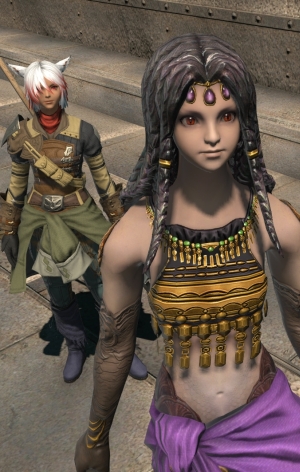
All right. It’s all over but the waiting, and that means it’s time to start picking apart the Final Fantasy XIV expansion we’re now on the back end of. Sure, my tradition of examining these things in depth is pretty limited as we’ve only had one prior expansion for it, but I figure now’s the time to start adding a second round. So let’s start in with the obvious place to start with Stormblood’s main story.
Unfortunately, this is a story that’s been met with a lot of player grousing basically since the expansion launch. People have complained about the split between Ala Mhigo and Doma giving the former short shrift, that the patches felt less focused compared to the overall Heavensward trajectory which had three very tightly focused story patches, that Lyse didn’t have enough of a character arc, and so forth. And yet for my money this was actually when the game found a more natural and even cadence for its overall storytelling, from start to finish.
 By necessity, any comparison of the game’s stories at this point will come down to Heavensward vs. Stormblood. I’ve already talked about the former’s main story, and the reality is that we tend to gloss over the parts of that tale that didn’t work so well. The resolution to the Ul’dah plotline being a complete non-starter, the rather aimless meandering in 3.4 and 3.5, the fact that the story suddenly chases a different antagonist in the middle when you kill Nidhogg only to bring that back later… we kind of gloss over all of this stuff in hindsight.
By necessity, any comparison of the game’s stories at this point will come down to Heavensward vs. Stormblood. I’ve already talked about the former’s main story, and the reality is that we tend to gloss over the parts of that tale that didn’t work so well. The resolution to the Ul’dah plotline being a complete non-starter, the rather aimless meandering in 3.4 and 3.5, the fact that the story suddenly chases a different antagonist in the middle when you kill Nidhogg only to bring that back later… we kind of gloss over all of this stuff in hindsight.
None of this makes the story of Heavensward bad, of course. It was a great story! It was just one that had a number of notable failings, some flabby parts, and they recede in memory when you’re not stuck wading through them.
Stormblood, on the other hand, addresses basically all of my complaints about Heavensward. No longer are the stories we’re being told about just getting through an area to reach another one; each zone story is inextricably tied to that actual locale. Our enemy remains the same as we trek through the zones, even if there are minor antagonists that shift and change over time. And the story ends conclusively when the expansion’s base set of quests ends, leading to a series of patch stories that serve as a bridge rather than a proper conclusion.
That last one is going to inspire some debate, and to a certain extent it’s something that’s going to give everyone different feelings. In some ways, it comes down to a debate about what the individual patch stories are supposed to be, and that’s not an answer that I think we yet have solidified.
To me, it feels like the base expansion story should wrap up the conflicts that the beginning outlines. When Patch X.0 hits and brings a new level cap and full-length main scenario, the end of that main scenario should bring that to a satisfying conclusion. Patches X.1 through X.5 should therefore be about serving as a coda for smaller issues and bringing us ahead to the next expansion, not about finishing the story that Patch X.0 left on the table.
This was kind of a failing before. Heavensward reached its conclusion in 3.3 in a very final way. We no longer really had much to do moving onward, there wasn’t a clear narrative throughline. By contrast, Stormblood’s patches provided an arc in and of themselves. We have to wrap things up in Ala Mhigo, then we need to wrap things up in Doma, whoops there’s more to wrap up there with the Empire than we thought, now we need to get more contact with the Empire, now we’re spinning up into a war…
It feels like the logical coda to what had already happened, extrapolating from earlier actions while also not being necessary to understand the main questline. There was a satisfying conclusion to start with. They’re not optional, but they feel like part of a separate line, as they should.
Some people would prefer that the patch stories continue the main story, and I understand that. It’s going to come down to taste, and I could write multiple more columns on the virtues and failings of both. For the moment, I’d like to just leave it at the idea that the MSQ here delivered a better narrative feel for me while also acknowledging that it was more of a thematic throughline than a narrative one. Your mileage may vary.

Instead, I want to turn my gaze on perhaps the most divisive element of the whole story, Lyse Hext. Lyse was very much the face of this expansion, her character development was meant to be a focal point, and she also gets the burden of animosity directed at her for not being sufficiently dynamic or developed or impressive or whatever.
And… yeah, no. That’s not actually right. The story makes its goals with Lyse very clear from the start and delivers on them.
When we find out that Lyse is, well, Lyse in patch 3.5, it’s clear that everything we’ve known about her up to this point is built upon a false pretense. She’s not actually Yda, she’s Lyse. And that right there is the premise that needs to be addressed. What does that actually mean? Who is Lyse? To us, she’s the same person she’s been the whole time because that’s just Yda with the mask off. Why bother revealing it?
It’s the exact same question she’s asking herself. She’s spent so much time being Yda that she’s never actually had that crucial period of time to grow into being her own person with a distinct identity; instead, she’s spent her time trying to be the likable image of her sister. Lyse’s entire identity revolved around that, and what we’ve seen of her up to this point is always marked by a profound need to avoid loss.
Over the course of the story we get a character who has defined herself around that need to avoid loss have to confront the idea of what she actually has to lose. She’s also still living in the shadow of her sister, right down to the fact that her outfit for most of the game is a variant on the one she’s always worn. She’s trying to be who she thinks Yda would want her to be. It’s why she and Hien get a moment in the prison cell because they’re both trying to develop identities in the wake of people who aren’t there any longer.
It’s also why her big change in costume is significant. I’ve seen it mocked as a stupid decision. “Oh, you’re establishing yourself by dressing up as your sister?” Except that’s not what’s happening here; symbolically, it’s the moment when Lyse stops trying to be her sister and starts inhabiting that space. It’s a sign that she’s still carrying her sister with her because of course she is, but she doesn’t need to pretend at it. She has an idea of who Lyse can be.
I can understand why some people found elements of the story more underwhelming. For all that, I think that when we look back on it, we’re going to see this as the better overall expansion story compared to its immediate predecessor. Of course, the future remains to be seen.
As always, feedback is welcome in the comments below or via mail to eliot@massivelyop.com. Next week, let’s start talking about the side stories in the expansion.
 Wisdom of Nym: Final Fantasy XIV: Stormblood in review – the final assessment
Wisdom of Nym: Final Fantasy XIV: Stormblood in review – the final assessment
 Wisdom of Nym: Final Fantasy XIV: Stormblood in review – odds and ends
Wisdom of Nym: Final Fantasy XIV: Stormblood in review – odds and ends
 Wisdom of Nym: Final Fantasy XIV: Stormblood in review – the trials
Wisdom of Nym: Final Fantasy XIV: Stormblood in review – the trials
 Wisdom of Nym: Final Fantasy XIV: Stormblood in review – expert dungeons
Wisdom of Nym: Final Fantasy XIV: Stormblood in review – expert dungeons
 Wisdom of Nym: Final Fantasy XIV: Stormblood in review – leveling content
Wisdom of Nym: Final Fantasy XIV: Stormblood in review – leveling content
 Wisdom of Nym: Final Fantasy XIV: Stormblood in review – side stories, part two
Wisdom of Nym: Final Fantasy XIV: Stormblood in review – side stories, part two
 Wisdom of Nym: Final Fantasy XIV: Stormblood in review – side stories, part one
Wisdom of Nym: Final Fantasy XIV: Stormblood in review – side stories, part one
 Wisdom of Nym: Final Fantasy XIV Stormblood in review – The main scenario
Wisdom of Nym: Final Fantasy XIV Stormblood in review – The main scenario
 The Nymian civilization hosted an immense amount of knowledge and learning, but so much of it has been lost to the people of Eorzea. That doesn’t stop Eliot Lefebvre from scrutinizing Final Fantasy XIV each week in Wisdom of Nym, hosting guides, discussion, and opinions without so much as a trace of rancor.
The Nymian civilization hosted an immense amount of knowledge and learning, but so much of it has been lost to the people of Eorzea. That doesn’t stop Eliot Lefebvre from scrutinizing Final Fantasy XIV each week in Wisdom of Nym, hosting guides, discussion, and opinions without so much as a trace of rancor.













